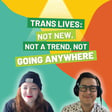
Pee. Panic. Repeat. What Trans People Face in Public Washrooms
In this episode, El and Kai step into the everyday world of washrooms and changing rooms - those ordinary spaces that, for many trans and non-binary people, are anything but simple. These are places where something as basic as peeing can come with an undercurrent of discomfort, scrutiny or even violence.
They talk about what it means to be seen (or questioned) in these spaces, and how the unspoken access rules - based purely on how someone looks - end up failing all of us, not just trans folks. Through unpacking what safety with all of us in mind really means, they explore how we might start to imagine washrooms that offer dignity, not dread.
If you’ve ever felt unsure, awkward or just curious about why washrooms matter so much in conversations about trans inclusion, this one’s for you.
Download our FREE resource - "Rethinking Safety in Washrooms" here: https://www.transfocus.ca/freeresourcedownload
___________
Want to get in touch? Contact us at podcast@transfocus.ca
Join us on social media:
LinkedIn | Instagram | TikTok | Threads | Facebook



















